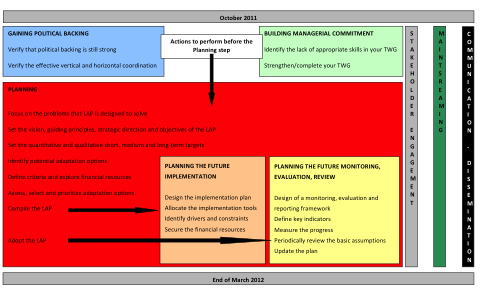
The Road Map for the Local Adaptation Plans LAPs: main findings and future steps.
On the basis of the outcomes of Action 2, which provided relevant scientific evidences on climate change scenarios in the target areas (Ancona-IT, Patras-GR and Bullas-SP) and drew the basic features for a successful adaptation, ISPRA (Institute for Environmental Protection and Research) defined the Road Map for the Local Adaptation Plans (LAPs), with the contribution of the municipalities involved in the project.
The Road Map thus represents the linkage between the Local Impact Assessments performed for each municipality and the concrete Local Adaptation Plans (LAPs), and is specifically addressed to: i. assist the municipalities in the formulation of their LAP and support their needs for process start up and development; ii. identify challenges and key approaches to be adopted locally for the coming adaptation process; iii. pave the way to a step-by-step comprehensive, science-based process tailored to future local needs.
For this purpose the Road Map includes a first part dedicated to the description of climate change observed trends and scenarios as well as current and projected impacts of climate change on the main vulnerable natural systems and socio-economic sectors in each municipality. The results of climate projections give reason to expect a number of consequences associated to climate change, but still many uncertainties, knowledge gaps and needs are identified. However, bridging the knowledge gaps represents a very challenging issue. Research is already considerable, but results are not always downscaled at local level and shared among local decision-makers.
Based on the main findings of the first part, in the second part a Road Map is designed as a tool finalised to lead the municipalities through the whole planning phase to the adoption of the Local Adaptation Plans (LAPs). Nine different tasks have been thus identified in the Road Map: i. review of the political backing; ii. review of the managerial commitment; iii. review of the assessment; iv. definition of the future planning; v. definition of the implementation system; vi. definition of the monitoring, evaluation and review system; vii. engagement of stakeholders; viii. mainstreaming of adaptation into sectoral policies; ix. communication and dissemination.
Adapting to climate change is an iterative process. This means that some tasks should be performed throughout the whole process or at a certain stage of it. Furthermore, some tasks should be revised periodically in order to ensure that data, assessments and resulting decisions remain valid and up-to-date.
In achieving their general objective of making the community a climate resilient community, the municipalities are recommended to respect general aspects for good adaptation. Furthermore, specific suggestions for future adaptation process at local level point out a strong need of actions aiming at creating information and developing the knowledge base in order to strengthen and build the adaptive capacity of their natural and human systems. Such type of actions will represent the foundation for delivering adaptation actions, which are actions that help to reduce vulnerability to climate risks or to exploit opportunities.

Figure 1 – Structure, tasks and recommended actions of the Road Map towards the Local Adaptation Plans.
Other news from the partners
With the contribution of the LIFE financial instrument of the European Community